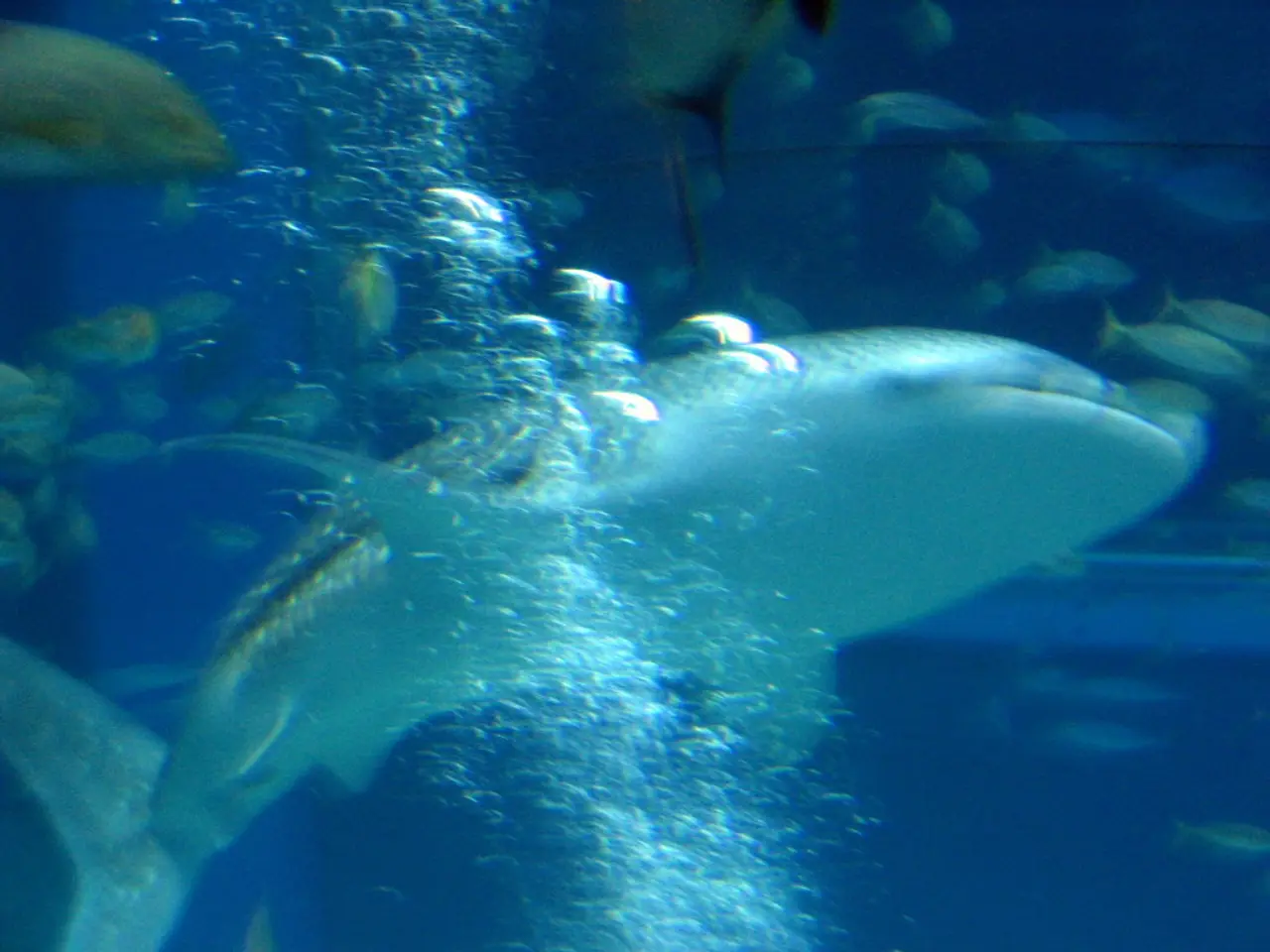Safety measures for swimming with sharks
In the vast, mysterious underwater world, encounters with sharks can be both exhilarating and awe-inspiring. However, it's essential to approach these apex predators with caution and respect.
Shark scientist Melissa Cristina Márquez, who has dedicated her life to studying these majestic creatures, emphasises the importance of understanding environmental factors before diving with any shark species, particularly large ones.
When in the water with sharks, maintaining calm and moving slowly are key. Sudden movements should be avoided, and it's best to avoid turning your back on the shark. Maintaining eye contact is also important, signalling awareness.
There are several species of sharks that divers might encounter, from the infamous great white to the gentle whale shark, the iconic hammerhead, and the pocket-sized dwarf lanternshark. Many shark species, such as hammerheads, puffadder shysharks, and thresher sharks, tend to be timid and avoid divers.
However, some species, like the spotted ragged-tooth shark, can grow up to 10 feet long and have terrifying-looking mouths with hundreds of needle-sharp teeth. Predatory sharks are most active during dusk and dawn, especially in murky water, and experienced professionals usually avoid these times.
When swimming with sharks, key safety protocols include swimming in groups rather than alone, avoiding entering the water with open cuts or bleeding wounds, and not wearing shiny jewelry or bright clothing. Swimming should be done during daylight hours, in clear, shallow waters, and without fishing or carrying dead fish. Heeding local warnings, lifeguard instructions, and posted shark sighting signs is also crucial.
In terms of body language and interaction, maintaining calm, composed behaviour is vital. Establishing eye contact and positioning your body to face the shark are good practices. Keeping a respectful distance of about 2 to 3 meters is recommended to stay within the shark’s comfort zone.
Observe for signs of shark agitation such as quick darting movements or an arched back, which indicate the shark needs more space. If a shark approaches aggressively, some protocols recommend gently pushing it away from the nose to deter it safely. Stay vigilant and monitor subtle changes in swimming patterns or posture that indicate discomfort or excitement in the shark.
These protocols are based on decades of expert research and practices implemented by respected shark diving operations in Hawaii, which maintain a strong safety record through such measures. Respecting sharks' natural behaviour and habitat, staying calm, and following local safety guidelines significantly minimise risks when swimming near them.
It's important to remember that shark encounters should be on the sharks' terms, giving them plenty of space and never chasing or cornering them. Swimming with sharks is a privilege, not a thrill-seeking stunt, and it's important to prevent stressing out the sharks.
Sharks have been on Earth for longer than trees, and human activities such as overfishing, habitat loss, and pollution threaten them more than humans themselves. Sharks are less likely to see humans as potential prey if you keep your eyes on them at all times.
Bertie Gregory, a renowned wildlife filmmaker, experienced his "all-time favorite" shark dive in the "spooky" Cathedral underwater cave in South Africa's Aliwal Shoal reef. As many as 40 spotted ragged-tooth sharks were present in the Cathedral cave. Sharks give off signals if you know how to read their body language. Signs of discomfort or agitation include jerky movements, raising the head, lowering pectoral fins, arching the back, and making exaggerated swishing tails, tighter circles, bumping objects, or several close passes.
There are more than 500 species of sharks, each with its unique behaviours and characteristics. Adult white sharks have evolved to eat seals and sea lions due to their energy-dense blubber.
In conclusion, swimming with sharks is an incredible opportunity to witness these ancient creatures in their natural habitat. By respecting their behaviour, staying calm, and following safety guidelines, we can ensure these encounters are safe and enjoyable for both humans and sharks.
- Shark scientist Melissa Cristina Márquez highlights the importance of understanding environmental factors before diving with any shark species, especially large ones.
- Sudden movements should be avoided when in the water with sharks, and it's best to maintain calm and move slowly.
- There are many shark species that divers might encounter, such as whale sharks, hammerheads, and dwarf lanternsharks, while some, like the spotted ragged-tooth shark, require extra caution due to their size and powerful jaws.
- Maintaining a safe distance of about 2 to 3 meters from sharks and avoiding entering the water with open cuts or bleeding wounds are key safety protocols.
- Sharks have been on Earth for longer than trees, yet human activities like overfishing, habitat loss, and pollution threaten them more than humans themselves.
- Swimming with sharks in a respectful and safe manner enriches our understanding of these ancient creatures and contributes to their conservation.
- By observing and understanding shark body language, divers can establish peaceful coexistence with these fascinating species, making outdoor-living experiences more enjoyable, and contributing to the health of our planet's ecosystems.




